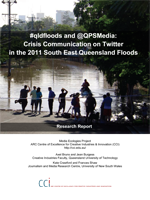Canberra.
It’s a rainy morning in Canberra, and I’ve made it to the inaugural conference of the Australasian Association for the Digital Humanities. The opening keynote is by Alan Liu, who begins by noting the rise of the ‘digital humanities’ concept, and its attendant controversies (what do we mean by the term, in the first place?).
Alan’s specific interest is in literary studies, and in the debate between ‘close’ and ‘distant’ reading. New critical close reading first forged the professional identity of the humanities, especially in literary studies, but distant reading has now emerged as a conscious agenda of …

 Twelve months ago Brisbane, and the South East Queensland region, were just about to begin the long process of recovery from the major floods which affected Toowoomba, the Lockyer Valley, Ipswich, and Brisbane itself. One of the more positive stories to emerge from the crisis, though, was how social media were used as a tool for sharing news and information about the disaster, and for assisting locals with organising the (significantly volunteer-driven) relief and recovery effort.
Twelve months ago Brisbane, and the South East Queensland region, were just about to begin the long process of recovery from the major floods which affected Toowoomba, the Lockyer Valley, Ipswich, and Brisbane itself. One of the more positive stories to emerge from the crisis, though, was how social media were used as a tool for sharing news and information about the disaster, and for assisting locals with organising the (significantly volunteer-driven) relief and recovery effort.











